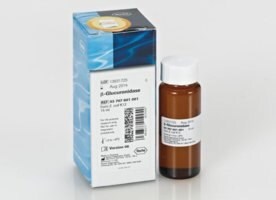Drug Analysis Enzymes

Glucuronidation by the human UDP-glucuronosyltransferase (UGT) family of enzymes plays an important role in the metabolic fate of many drugs and other xenobiotics. This reaction also has a role in the conjugation and excretion of endogenous substrates, such as bile acids, bilirubin, and steroids.
β-Glucuronidase (beta-Glucuronidase)
β-D-Glucuronide glucuronosohydrolase enzymes (β-glucuronidase), are critical for determining the presence of metabolites in biological samples for drug metabolism and drug screening studies. β-Glucuronidase hydrolyzes glucuronide metabolites back to the native parent drug and is often necessary for drug detection in complex biological samples. Due to its critical role in carbohydrate metabolism, β-glucuronidase is present in many biological systems. Variables such as β-glucuronidase enzyme concentration, incubation time, digestion pH, and temperature all play important roles for effective hydrolysis of glucuronide metabolites and should be considered for each downstream application.
Enzymes for Conjugate Analysis
- β-Glucuronidase – β-Glucuronidases available from numerous sources, including mollusks, bovine liver, abalone, and E. coli.
- Sulfatase – available from sources, including Helix pomatia, and Patella vulgata – aids in the formation of thiohydroximates.
β-D-Glucuronide glucuronosohydrolase enzymes (β-glucuronidase), are critical for determining the presence of metabolites in biological samples for drug metabolism and drug screening studies. β-Glucuronidase hydrolyzes glucuronide metabolites back to the native parent drug and is often necessary for drug detection in complex biological samples. Due to its critical role in carbohydrate metabolism, β-glucuronidase is present in many biological systems. Variables such as β-glucuronidase enzyme concentration, incubation time, digestion pH, and temperature all play important roles for effective hydrolysis of glucuronide metabolites and should be considered for each downstream application.
Enzymes for Conjugate Analysis
- β-Glucuronidase – β-Glucuronidases available from numerous sources, including mollusks, bovine liver, abalone, and E. coli.
- Sulfatase – available from sources, including Helix pomatia, and Patella vulgata – aids in the formation of thiohydroximates.
To continue reading please sign in or create an account.
Don't Have An Account?